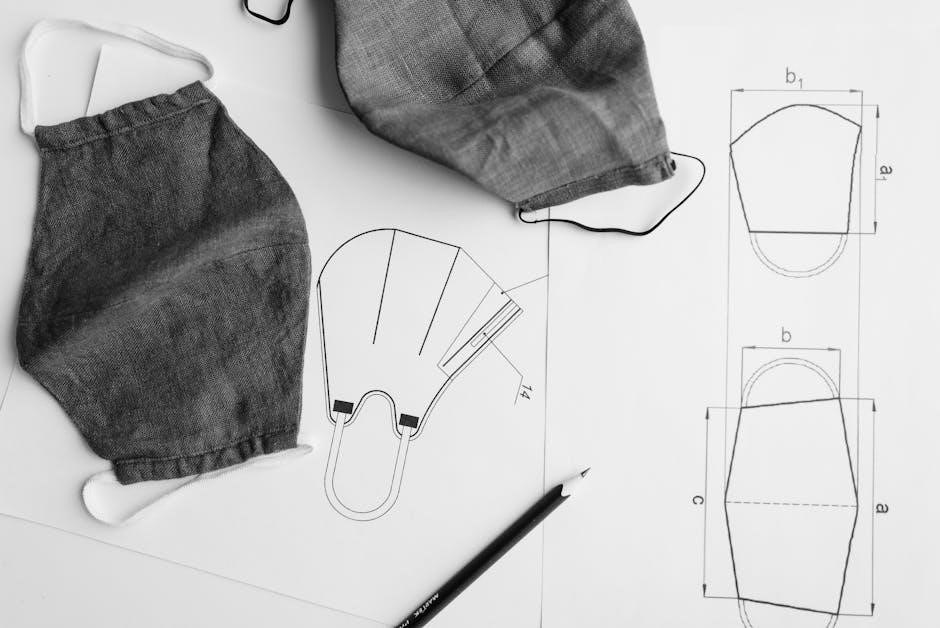
The Black and Decker All-In-One Breadmaker is a versatile and user-friendly appliance designed to simplify bread making at home. It offers multiple settings for various bread types and dough preparation, making it ideal for both novices and experienced bakers. The comprehensive user manual provides detailed instructions for safe and optimal use, ensuring delicious results every time. Regular maintenance, like oiling the bread pan, keeps the machine in top condition for years of reliable service.
Overview of the Breadmaker and Its Features
The Black and Decker All-In-One Breadmaker is a versatile and modern appliance designed to make bread-making effortless and enjoyable. This breadmaker comes equipped with a range of features that cater to both novice and experienced bakers. One of its standout features is the delay start timer, which allows users to prepare dough in advance and have freshly baked bread ready at a specific time. This feature is particularly convenient for busy households.

The breadmaker also boasts a non-stick baking pan and a kneading paddle, both of which are designed for easy dough handling and effortless cleanup. The non-stick surface ensures that bread releases smoothly, reducing the risk of tearing or sticking. Additionally, the machine is equipped with multiple preset settings, including options for white bread, whole wheat, and dough preparation. These settings allow users to customize their bread-making experience based on their preferences.
Another notable feature is the automatic temperature control, which ensures consistent baking results by maintaining the ideal temperature throughout the process. The machine also includes a large viewing window, enabling users to monitor the progress of their bread without interrupting the baking cycle. This feature is especially useful for first-time users who want to observe how their dough transforms into bread.
The Black and Decker All-In-One Breadmaker is also designed with ease of use in mind. The control panel is intuitive, featuring clear buttons and an LCD display that guides users through the bread-making process. The machine’s compact design makes it a perfect fit for kitchens of all sizes, while its durable construction ensures long-lasting performance.

Regular maintenance is essential to keep the breadmaker in optimal condition. The user manual recommends periodic oiling of the bread pan and kneading shaft to prevent rust and ensure smooth operation. This simple step can significantly extend the lifespan of the machine. With its robust features and user-friendly design, the Black and Decker All-In-One Breadmaker is an excellent choice for anyone looking to explore the world of homemade bread.
Importance of the User Manual for Optimal Use

The user manual for the Black and Decker All-In-One Breadmaker is an essential resource for ensuring optimal performance and safety. It provides detailed instructions that guide users through every aspect of the breadmaker’s operation, from initial setup to advanced features. By following the manual, users can avoid common mistakes and ensure their breadmaker functions efficiently for years to come.
The manual begins with critical safety guidelines, such as avoiding contact with hot surfaces and preventing electric shock by keeping the cord and plug dry. These precautions are vital for safe operation, especially in busy households. Additionally, the manual offers step-by-step instructions for assembling and preparing the breadmaker before its first use, including cleaning the parts and understanding the control panel layout.
One of the most valuable aspects of the manual is its troubleshooting section. It addresses common issues, such as overly wet or dry dough, and provides practical solutions. For example, the manual suggests periodically checking the dough during the baking process to adjust ingredients if necessary; This simple habit can prevent failed loaves and ensure consistent results.
The manual also includes maintenance tips, such as regularly oiling the bread pan and kneading shaft to prevent rust and ensure smooth operation. These small steps can significantly extend the lifespan of the machine and maintain its performance over time. Furthermore, the manual provides clear explanations of the breadmaker’s features, such as the delay start timer and automatic temperature control, helping users maximize their baking experience.

For those new to bread making, the manual serves as a comprehensive guide, offering insights into the basics of bread preparation and the machine’s capabilities. It also includes a variety of recipes and tips for experimenting with different types of bread, from classic white loaves to whole wheat and artisan-style varieties. By referring to the manual, users can unlock the full potential of their breadmaker and enjoy fresh, homemade bread with ease.

Safety Guidelines for Using the Breadmaker
Ensure safe operation by following essential precautions. Never touch hot surfaces or components; use oven mitts or handles to avoid burns. To prevent electric shock, keep the cord, plug, and machine dry—never submerge them in water. Regularly inspect the power cord for damage and avoid overloading electrical outlets. Keep children away from the machine during operation. Always unplug the breadmaker when not in use or during cleaning to maintain safety standards. Proper adherence ensures a secure and enjoyable baking experience.
Important Safety Precautions
When using the Black and Decker All-In-One Breadmaker, it is crucial to follow essential safety guidelines to ensure safe and optimal operation. Always read the user manual thoroughly before first use, as it provides detailed instructions for proper handling and maintenance. Avoid touching hot surfaces, such as the breadmaker’s exterior or baking chamber, as they can cause burns. Use oven mitts or handles to manage the machine during operation. To prevent electric shock, never submerge the cord, plug, or machine in water or expose them to excessive moisture. Keep the breadmaker on a stable, heat-resistant surface away from flammable materials. Regularly inspect the power cord and plug for damage; if damaged, discontinue use immediately and contact a professional for repairs. Avoid overloading electrical outlets or using damaged extension cords, as this can lead to fire hazards. Supervise children when the breadmaker is in operation, as they may accidentally touch hot or moving parts. Always unplug the machine when not in use or during cleaning to minimize risks. For safe operation, ensure the machine is placed on a flat, even surface and avoid opening the lid during the baking cycle, as hot steam may cause burns. Only use accessories and parts recommended by the manufacturer to maintain safety and performance. Regularly clean the breadmaker and its components to prevent the buildup of residue, but avoid using abrasive cleaners or scourers that could damage the finish. By adhering to these precautions, you can enjoy safe and efficient breadmaking with your Black and Decker All-In-One Breadmaker.
Handling Hot Surfaces and Electrical Components
Handling hot surfaces and electrical components of the Black and Decker All-In-One Breadmaker requires careful attention to ensure safety and prevent accidents. The breadmaker’s exterior and baking chamber can become extremely hot during operation, so it is essential to avoid direct contact with these areas; Always use oven mitts or heat-resistant handles when removing the bread pan or handling the machine during or after use. Never touch the glass lid, heating elements, or other hot surfaces with your bare hands, as this can result in severe burns.
When managing electrical components, ensure the cord and plug are kept away from water and excessive moisture to avoid the risk of electric shock. Avoid submerging any part of the breadmaker in water, as this can damage the machine and pose a significant safety hazard. If the machine is not in use, always unplug it to prevent accidental start-ups or electrical issues. Additionally, regularly inspect the power cord and plug for signs of wear or damage; if damaged, discontinue use and contact a professional for repairs.
Handling the machine’s electrical components with wet hands or while standing on a damp surface is strongly discouraged, as it increases the risk of electric shock. Keep the breadmaker on a stable, heat-resistant surface, away from flammable materials such as curtains or towels. When cleaning the machine, avoid using abrasive cleaners or scouring pads, as they may damage the finish or harm electrical components. Instead, wipe down surfaces with a soft cloth and mild detergent, ensuring all parts are dry before resuming use.
By following these guidelines, you can safely handle hot surfaces and electrical components of your Black and Decker All-In-One Breadmaker, ensuring optimal performance and longevity while minimizing risks. Always prioritize caution and adhere to the manufacturer’s recommendations for safe operation.
Protecting Against Electric Shock

Protecting against electric shock is a critical aspect of safely operating the Black and Decker All-In-One Breadmaker. Electrical appliances, especially those used in kitchens, can pose risks if not handled properly. To ensure your safety and the longevity of the machine, follow these essential precautions:
First, never immerse the cord, plug, or any electrical component of the breadmaker in water or expose them to excessive moisture. This includes avoiding the use of wet hands when handling the machine or its electrical parts, as this can conduct electricity and lead to shock. Additionally, keep the breadmaker away from water sources, such as sinks or countertops prone to spills, to minimize accidental exposure.
Always ensure the machine is placed on a dry, stable surface. Avoid operating the breadmaker in humid environments or near puddles of water, as this increases the risk of electrical hazards. If the machine is not in use, unplug it from the power source to prevent accidental start-ups or electrical surges.

Regularly inspect the power cord and plug for signs of damage, such as frays, cuts, or burn marks. If you notice any wear or tear, discontinue use immediately and contact a qualified technician for repairs. Never attempt to repair the machine yourself, as this can lead to further damage or expose you to electrical risks.
When cleaning the breadmaker, avoid using excessive water or wet cloths near the electrical components. Instead, wipe down the exterior and control panel with a dry or slightly damp cloth, ensuring all surfaces are completely dry before plugging the machine back in. This prevents moisture from seeping into internal mechanisms and causing electrical malfunctions.
By adhering to these precautions, you can effectively protect against electric shock and ensure a safe baking experience with your Black and Decker All-In-One Breadmaker. Always prioritize caution when working with electrical appliances to avoid potential hazards.

Setting Up and Preparing the Breadmaker
Before using your Black and Decker All-In-One Breadmaker, unpack and inspect all components. Wash the bread pan, kneading paddle, and measuring utensils with warm soapy water, then dry thoroughly. Assemble the parts according to the manual, ensuring the pan clicks securely into place. Familiarize yourself with the control panel to understand its functions. Periodically oil the bread pan and kneading shaft to maintain smooth operation and prevent rust. Proper setup ensures optimal performance and delicious results.
Before First Use: Cleaning and Preparation
Before using your Black and Decker All-In-One Breadmaker for the first time, it is essential to thoroughly clean and prepare the appliance to ensure optimal performance and prevent any unwanted odors or residues. Start by unpacking all components, including the bread pan, kneading paddle, and measuring utensils. Wash these parts with warm, soapy water to remove any manufacturing oils or sediments that may have been left behind. Rinse thoroughly and dry with a clean towel to prevent water spots.
Once cleaned, inspect the bread pan and kneading paddle for any signs of rust or damage; If necessary, lightly oil these parts to protect them and ensure smooth operation. This step is crucial for maintaining the longevity of your breadmaker. Next, familiarize yourself with the machine’s exterior and control panel. Wipe down the exterior with a damp cloth to remove any dust or packaging residue.
Before assembling the parts, ensure all components are completely dry. Place the bread pan into the machine, making sure it clicks securely into position. Attach the kneading paddle to the shaft inside the pan, following the alignment guide in the manual; Proper assembly is vital for even mixing and kneading of the dough.
Regular maintenance is key to keeping your breadmaker in excellent condition. After the initial setup, periodically oil the bread pan and kneading shaft to prevent rust and ensure smooth movement. This simple habit will extend the life of your appliance and guarantee consistent results with every batch of bread.
By following these preparation steps, you can ensure your Black and Decker All-In-One Breadmaker is ready for its first use, providing you with fresh, homemade bread for years to come.
Assembling the Parts and Accessories
Assembling the Black and Decker All-In-One Breadmaker is a straightforward process that ensures optimal functionality. Upon unboxing, you will find the main unit, bread pan, kneading paddle, measuring cup, and measuring spoon. Before assembling, ensure all parts are clean and dry, as outlined in the manual.
Start by locating the bread pan, which is the core component of the breadmaker. Carefully lift the pan and align its metal handle with the corresponding slot on the machine’s base. Gently twist the handle counterclockwise until it clicks into place, securing the pan firmly. This ensures proper alignment and smooth operation during the kneading and baking cycles.
Next, attach the kneading paddle to the shaft located inside the bread pan. The paddle is designed with a non-stick coating to prevent dough from sticking and to make cleanup easier. Align the paddle’s post with the shaft and gently push it down until it clicks into position. Ensure it is securely locked to avoid any movement during use.
Once the bread pan and kneading paddle are in place, familiarize yourself with the machine’s accessories. The measuring cup and spoon are essential for accurate ingredient measurements, which are critical for achieving the perfect loaf. Store these accessories near the machine for easy access when preparing recipes.
Before proceeding, double-check that all parts are correctly assembled and properly fitted. Handle the components with care to avoid scratching or damaging the non-stick surfaces. If you notice any misalignment or looseness, adjust the parts accordingly to ensure smooth operation.

Proper assembly is crucial for the breadmaker’s performance and longevity. By following these steps, you can ensure that your Black and Decker All-In-One Breadmaker is ready to produce delicious homemade bread with ease. Always refer to the user manual for visual guidance and additional tips on maintaining your appliance.
Understanding the Control Panel Layout
The control panel of the Black and Decker All-In-One Breadmaker is designed to be intuitive and user-friendly, making it easy to navigate and customize your bread-making experience. Located on the top of the machine, the control panel features a clear LCD display and a series of buttons that allow you to select settings, monitor progress, and adjust recipes to your liking.
The LCD display provides real-time information about the current mode, timer, and progress of the bread-making cycle. It lights up during operation, ensuring visibility even in low-light conditions. Below the display, you will find a set of buttons that control various functions, including the menu selection, start/stop operation, and timer adjustment. These buttons are clearly labeled and feature a responsive design for easy navigation.
One of the standout features of the control panel is the ability to choose from multiple pre-programmed settings. These settings cater to different types of bread, such as basic, whole wheat, French, and gluten-free, as well as options for dough, jam, and cake. By using the menu button, you can scroll through these options and select the one that best suits your recipe. Once selected, the machine will automatically adjust the kneading, rising, and baking times to ensure optimal results.
In addition to the pre-programmed settings, the control panel allows for customization. You can adjust the crust color (light, medium, or dark) and delay the start time, enabling you to prepare ingredients in advance and have freshly baked bread ready at a specific hour. The timer function is particularly useful for busy households, as it ensures your bread is baked to perfection without constant supervision.
Understanding the control panel layout is essential for maximizing the potential of your breadmaker. By familiarizing yourself with its features and functions, you can explore a wide range of recipes and tailor your bread-making experience to suit your preferences. The clear design and logical layout make it accessible to both novice and experienced users, ensuring a seamless and enjoyable baking process.